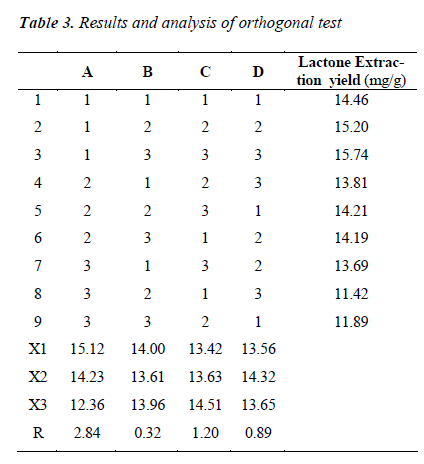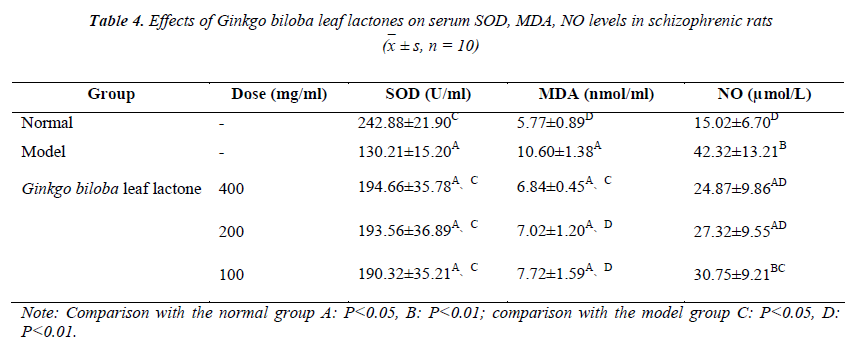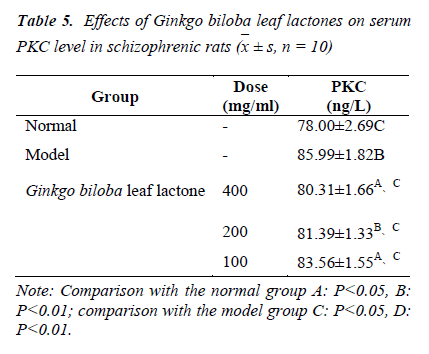ISSN: 0970-938X (Print) | 0976-1683 (Electronic)
Biomedical Research
An International Journal of Medical Sciences
- Biomedical Research (2015) Volume 26, Issue 1
Study on the determination of lactone contents in Ginkgo biloba leaves and their effects in schizophrenia.
Wei Zhang and Shouxin Liu*
Department of Pharmacy, The First Affiliated Hospital of Dalian Medical University, Dalian 116011, China
- Corresponding Author:
- Shouxin Liu
Department of Pharmacy
The First Affiliated Hospital of Dalian Medical University,
Dalian 116011, China
Accepted date: September 13 2014
Ginkgo biloba leaf is the leaf of Ginkgo biloba L. in the genus Ginkgo of family Ginkgoaceae. It has the actions of benefiting heart, astringing lung, resolving dampness and stopping diarrhea, which can be used in the treatment of chest distress and pain, palpitation, phlegm panting and cough, diarrhea, dysentery, leucorrhea and other symptoms. Main active constituents of Ginkgo biloba leaves are lactones and flavonoids. To investigate the extraction process of lactones from Ginkgo biloba leaves. To study the effects of Ginkgo biloba leaf extract on serum levels of superoxide dismutase (SOD), malondialdehyde (MDA), nitric oxide (NO) and protein kinase C (PKC) in rat model of schizophrenia. With the total contents of three types of lactones in Ginkgo biloba leaves as the indicators, the influences of four factors, extraction time (A), extraction temperature (B), ethanol concentration (C) and ethanol amount (D), on the extraction yield of Ginkgo biloba leaves were investigated. Schizophrenia model was established, SD rats were randomly divided into five groups: normal group (A), model group (B), Ginkgo biloba leaf extract highdose group (C), Ginkgo biloba leaf extract medium-dose group (D) and Ginkgo biloba leaf extract low-dose group (E), changes in serum SOD, MDA and NO levels were determined by biochemical methods, and serum PKC level by avidin-biotin complex-ELISA (ABC-ELISA). The optimal extraction process of lactones from Ginkgo biloba leaf was determined to be A3B1C3D1. Compared with the model group, each Ginkgo biloba leaf extract group was all able to improve the general condition of rats in different degrees, and significantly lower serum MDA, NO levels (P<0.05 or P<0.01), increase SOD activity (P<0.05 or P<0.01), and reduce the pathological damage caused by oxygen free radicals. Each Ginkgo biloba leaf extract group could significantly lower serum PKC level (P<0.05 or P<0.01). The process was capable of effectively extracting lactones from Ginkgo biloba leaves. Ginkgo biloba leaf extract can reduce pathological damage in schizophrenic model rats, and plays a protective role in the damage caused by oxygen free radicals; it can decrease serum concentration of PKC, and thus plays a regulatory role in the gap junctional intercellular communication (GJIC) functionality.
Keywords
Ginkgo biloba leaf, lactone, orthogonal design, protein kinase C, schizophrenia.
Introduction
Ginkgo biloba leaf is the leaf of Ginkgo biloba L. in the genus Ginkgo of family Ginkgoaceae. According to the records of Chinese materia medica, Ginkgo biloba leaf has the actions of benefiting heart, astringing lung, resolving dampness and stopping diarrhea, which can be used in the treatment of chest distress and pain, palpitation, phlegm panting and cough, diarrhea, dysentery, leucorrhea and other symptoms. Main active constituents of Ginkgo biloba leaves are lactones and flavonoids. In the literature, lactones are often regarded as volatile oils and extracted by steam distillation, but most of lactones in Ginkgo biloba leaves have a high boiling point, so steam distillation method is not suitable. In this study, solvent extraction method was used for simultaneous extraction of three major lactone constituents in Ginkgo biloba leaves: ginkgolide A, ginkgolide B and ginkgolide C. Meanwhile, the influences of extraction time, extraction temperature, ethanol concentration and ethanol amount on the extraction yield of Ginkgo biloba leaves were investigated by orthogonal design with the total contents of the above three types of lactones as the indicators. The process is simple, rational, and easy to operate, which provides a reference for the industrial production of the Ginkgo biloba leaf lactone compounds.
Based on preliminary experiment, we found that the crude extract of Ginkgo biloba leaves has some role in schizophrenia. Schizophrenia is a common chronic mental illness mainly characterized by highly uncoordinated mental activity and the environment. The onset of schizophrenia is associated with various factors and is relatively complex, it has been reported in the literature that the pathogenesis of schizophrenia is neurotransmitter dysfunction [1], which results in the abnormality of GJIC that regulate nerve cells2. Studies have confirmed that cell injury mediated by oxidative stress is involved in the pathophysiology of schizophrenia, and can lead to cell GJIC dysfunction.
Traditional Chinese physicians believe that qi stagnation and phlegm coagulation are potential pathogenesis of schizophrenia, treatment starts mostly with "phlegm", and Ginkgo biloba leaves have such effect. In the present experiment, through the detection of superoxide dismutase (SOD), malondialdehyde (MDA), nitric oxide (NO) and protein kinase C (PKC) in the schizophrenic model SD rats, the protective role of Ginkgo biloba leaf extract against oxidative damage and its GJIC regulatory functionality through PKC are explored, providing the basis for novel drug development.
Materials
Animals and grouping
50 SD rats of clean grade, 180-220 g, animal certificate No.: SDYK 2013-09230, were provided by the SPF Laboratory Animal Center of Chengdu College of TCM.
Drugs and reagents
Dizocilpine maleate (Ligva, Germany); SOD kit (lot No. 20130723), MDA test kit (lot No. 20130920), NO test kit (lot No. 20130211) were all provided by Chongqing Yuanchengxiang Biological Agents Co., Ltd.; PKC ELISA kit (Cusabio Biotech, LTD. lot No. A21307224). Ginkgo biloba leaf extract was self-prepared. Ginkgolide A, B, C reference substances were provided by the National Institute for Control of Pharmaceutical and Biological Products, lot No.: 20130623, 20130415, 20130542, purity: 98.98%, 99.69%, 99.90%, respectively. Water used was self-purified water, chromatography reagents were of HPLC grade, and separation reagents of analytical grade.
Instruments
Electronic balance (Shanghai Gaoneng Precision Instrument Co., Ltd.); UV-2100 UV-Vis spectro-photometer (Shanghai Kenilong Instrument Co., Ltd.); MULTISKAN FC microplate photometer (Thermo), WELLWASH 888 microplate washer (Thermo) . Waters HPLC dual wavelength UV-Vis detector. Millipore water purifier.
Experimental methods
Study on the extraction process of Ginkgo biloba leaf lactones
Chromatographic conditions
Chromatographic column: Kromasil-C18 (4.6 mm X 150 mm); gradient elution mobile phase: methanol: 1% acetic acid aqueous solution (50:50→100:0); flow rate: 0.8 mL/min; detection wavelength: 280 nm.
Plotting of standard curves
Appropriate amounts of ginkgolide A, B, C reference substances were precisely weighed, and prepared separately into stock solutions with a concentration around 1 g/L with methanol. The ginkgolide A, B, C stock solutions were prepared into a series of mixtures of different concentrations with methanol, 10 μL of samples were injected, linear regression was performed with respective peak area and concentration, and regression equations were obtained as shown in Table 1.
Test sample determination method
Test samples were filtered through 0.45 μm membrane, and 10 μL were injected, regression equations were introduced, and quantification was carried out by external standard method.
Selection of factors and levels for extraction process of Ginkgo biloba leaf lactones
The range of factors and levels being investigated by the orthogonal test was determined based on the results of preliminary experiment, design scheme and analysis are shown in Tables 2, 3.
Study on anti-schizophrenic effect of ginkgolides
The preparation of drug
The Ginkgo biloba extraction is prepared according to the best extraction process. After freeze dried, the extract dilutes with saline. The drug is prepared into high dose of Ginkgo biloba lactone (100 mg/ml), meddle dose of Ginkgo biloba lactone (200 mg/ml), low dose of ginkgo biloba lactone (400 mg/ml).
Grouping, administration and model establishment [3]
Rats were randomly divided into five groups: normal group (A), model group (B), Ginkgo biloba leaf lactone high-dose group (C), medium-dose group (D) and lowdose group (E), n=10 in each group. Before model establishment, rats in the Ginkgo biloba leaf lactone high-, medium- and low-dose groups were continuously administered ig at a dose of 20 mL/kg, once per day; normal group and model group were given ig with equivalent normal saline once per day 20 mL/kg, each group was administered for 21 consecutive days. 2 h after the last administration, rats in the groups B, C, D, E were given ip with 0.6 mg/kg MK-801 in the left abdominal cavities to induce SD rat model of schizophrenia, normal group received an equivalent volume of saline injection.
Index measurement
After model establishment, the behavioral activities, appearance signs, and stool and urine properties of rats in each group were observed, 3 d later, the rats were sacrificed, and sera were collected for determination of SOD, MDA, NO and PKC levels.
Statistical analysis
Statistical analysis was performed using SPSS 11.5 package,
all data were expressed as  ± s, means of groups
were analyzed by one-way ANOVA, and pairwise comparison
between groups was performed by LSD test;
P<0.05 was considered statistically significant.
± s, means of groups
were analyzed by one-way ANOVA, and pairwise comparison
between groups was performed by LSD test;
P<0.05 was considered statistically significant.
Results
Orthogonal test and data analysis
It can be seen from the experimental data and range analysis results that extraction time (A) and ethanol concentration (C) were important factors influencing the extraction yield of Ginkgo biloba leaf total lactones, followed by the solvent volume (D), while the influence of extraction temperature (B) was comparatively small.
Thus, the extraction time (A) was selected to be A3; ethanol concentration (C) was selected to be C3; the difference in extraction temperature (B) among various levels was not significant, and Bl was selected in order to reduce energy consumption; extraction solvent volume (D) was selected to be D1. Hence, the optimal extraction process of Ginkgo biloba leaf lactones was: A3B1C3D1.
General condition of rats
No rat died during the model establishment, rats in the normal group were lively and active, with shiny furs, smooth breathing, and normal stool and urine; rats in the model group presented mental restlessness, with involuntary shaking of the head, torso twisting, uneasy limbs, excessive sensitivity to stimuli, and visible fur bristling; urine increased, while stool was normal; rats in the Ginkgo biloba leaf lactone groups had conditions similar to that in the model group. But with the extension of time, the condition of rats in each Ginkgo biloba leaf lactone group markedly improved compared with the model group. It shows that mental restlessness ease obviously, involuntary shaking of the head, torso twisting and the wave of limbs reduced, urine was back to normal, stool was normal.
Changes in serum SOD, MDA, NO, PKC levels in rats Compared with the normal group, serum levels of MDA, NO, PKC were significantly increased and SOD activity was significantly decreased in the model group, the differences were significant (P<0.05, P<0.01). Each dose group of Ginkgo biloba leaf lactones all decreased serum MDA, NO, PKC levels, and elevated SOD activity, which were significantly different compared with the model group (P<0.05, P<0.01). The results are shown in Tables 4, 5.
Discussion
Etiology hypothesis of schizophrenia believes that glutamate N-methyl-D-aspartate (NMDA) receptor function plays an important role in the pathophysiology. Dizocilpine maleate (MK-801) can highly selectively antagonize NMDA receptors, and thus is widely used in the study of animal models of schizophrenia. MK-801 can cause a range of behavioral changes in rodents, including increased locomotor activity, stereotyped behavior, ataxia, sensorimotor gating disorders, social dysfunction, etc. MK-801-induced lesions in schizo-phrenic model rats are similar to the qi stagnation and phlegm coagulation in the theory of TCM.
It has been reported in the literature that the blood levels of various antioxidant substances and lipid peroxides are abnormal in patients suffering from schizophrenia4. It can be simply inferred that the excessive generation of free radicals in the brain or weakened physiological clearance function in patients leads to increased lipid peroxidation and enhanced neurotoxicity. This may play some role in the occurrence of the disease. A study has shown that5 some therapeutic drugs can affect the metabolism of free radicals. These indicate that the treatment of schizophrenia can be achieved by regulating the metabolism of free radicals in the body.
Superoxide dismutase (SOD) plays a vital role in the body's oxidative-antioxidative balance, it can scavenge superoxide anion radicals (O-2), and thus protects cells from damage, which reflects protective capacity against cell damage in some extent. Malondialdehyde (MDA) level is an important index reflecting the degree of lipid peroxidation and level of free radicals within the body [6,7], MDA can indirectly reflect the severity of free radical attack to body cells. In this study, SOD activity in the model group was significantly lower while MDA was significantly increased compared with the normal group and Ginkgo biloba leaf lactone groups. The experimental results showed significant inter-group differences (P<0.05 or P<0.01), which were consistent with other reports [5,8].
NO is an important regulatory substance in intercellular transfer of information, which participates broadly in the pathophysiological processes of cardiovascular, nervous and immune systems [9].
Relevant studies have shown that NO has both neuroprotective and neurotoxic effects in the central nervous system. Oxidized NO (NO+) reacts with thiol (-SH) of Nmethyl- D-aspartate receptor (NMDAR) to lower NMDAR activity, inhibit Ca2+ influx, block glutamate acid (Glu) conduction, and avoid Ca2+ overload-induced toxicity in cells, and thereby plays a neuroprotective role. Reduced NO (NO- ) combines with O- to form peroxynitrite anion (ONOO-) [10], ONOO- enables nitration of amino acids such as tyrosine and tryptophan, resulting in inactivation of tyrosine hydroxylase, SOD and other important enzymes, and thus affects cell metabolism, damages mitochondrial structure and intracellular Ca2+ homeostasis, causes DNA strand breaks by acting with nucleic acids, and initiates lipid peroxidation by reacting with lipids11 thereby causing tissue damage. In this study, NO level in the model group increased significantly compared with the normal group and the Ginkgo biloba leaf lactone groups, showing significant inter-group differences (P<0.05 or P<0.01), which were similar to other relevant reports [11, 12].
The present experiment found that after MK-801- induction of schizophrenia in rats, SOD decreased, while MDA and NO elevated. After treatment with Ginkgo biloba leaf lactones, SOD increased, while MDA and NO decreased in model rats, indicating that Ginkgo biloba leaf lactones can improve hippocampal tissue metabolism, scavenge free radicals, reduce the accumulation of oxygen free radicals in the body, and relieve hippocampal tissue damage caused by significantly increased NO and free radicals as a result of schizophrenia. Through the above multiple links, Ginkgo biloba leaf lactones exert a protective effect against oxidative damage in schizophrenic model rats.
Protein kinase C (PKC) is a serine/threonine kinase family member, and an effector in the G protein-coupled receptor system, which can be activated by diacylglycerol and calcium ions. However, the activation of PKC is lipid-dependent, and at the same time, Ca2+ -dependent. When the membrane lipid DAG appears in the plasma membrane, PKC in the cytosol is bound to the plasma membrane, and then activated by the action of Ca2+ . PKC can activate target enzymes in the cytoplasm and thereby participates in the regulation of biochemical reactions, meanwhile, it can also act on transcription factors in the nucleus, and is involved in the regulation of gene expression, yet the genes regulated are mostly associated with the cell growth and differentiation [13].
The results of the present experiment showed that the serum PKC level of rats in the model group was significantly higher than the normal group, and the difference was statistically significant (P<0.05 or P<0.01). Serum PKC level of rats in each Ginkgo biloba leaf lactone group significantly lowered compared with the model group, and the differences were statistically significant (P<0.05 or P<0.01). The results showed that Ginkgo biloba leaf lactones can reduce serum PKC concentration in model rats, PKC may upregulate GJIC functionality through the above mechanisms, however, how Ginkgo biloba leaf lactones regulate GJIC functionality by reducing serum PKC concentration needs further study.
References
- Yang N, Sui F, Jiang YL. Glutamate Transporters Involved in Disorders of Central Nervous System. Chinese Journal of Experimental Traditional Medical Formulae 2011, 17: 255-258.
- Fu YL, Wan HJ, Zhu JH, Ma GQ. Effect of Wendan Decoction on Connexin 43 mRNA Expression of in Rat Brain Tissue with Schizophrenia Induced by Dizocilpine Maleate. Chinese Journal of Experimental Traditional Medical Formulae 2012, 18: 173-175.
- Wu JH, Zou H, Yu J, Zhou XD, Xie QL, Jin ML. Animal models of schizophrenia using different laboratory mouse strains. Acta Physiologica Sinica 2003, 55: 381-387.
- Zhang XY, Zhou DF, Zhang PY, Su JM, Cheng XF, Zhao YH, Nan ZG, Cui Y, Liu J, Gao SY, Guan ZQ, Sun LL. Association between schizophrenic immunity and superoxide dismutase. Chinese Journal of Nervous and Mental Diseases 2000, 26: 187-188.
- Gao YL, Yuan YW, Liu XC. Effects of huperzine A tablets on memory and antioxidant enzymes in rat model of schizophrenia. Chinese Journal of Nervous and Mental Diseases 2005, 31: 136-143.
- Yang ZW, Zhou Y, Cao XQ. Anti-coxsackie B3 virus activity of alkaloids in Sophora alopecuroide in vitro. Journal of Sichuan Traditional Chinese Medicine 2003, 21: 14-16.
- Nie HM, Chen JJ, Gao YQ, Jin SG, Wang LT. Experimental study on anti-hepatitis B virus effect of sophoridine in vitro. Beijing Journal of Traditional Chinese Medicine 2007; 10: 678-680.
- Wan HJ, Yang CP, He YS, Ye HP, Zhu JH, Wang MZ. Effect of Wendan Decoction on Immunoregulation And anti-oxidize in Rats with Schizophrenia. Journal of Jiangxi University of Traditional Chinese Medicine 2008; 20: 58-60.
- Liu GT. Research prospects of nitric oxide. National Medical Journal of China 1996; 76: 563-265.
- Lipton SA, Stamler JS. Actions of redox-related congeners of nitric oxide at NMDA receptor. Neuropharmacol 1994; 33: 1229-1233.
- Qin JL, Zhang WH. Effect of Nao Shuan Tong on the activity of SOD in cerebral tissues and NO in serums in the cerebral ischemia rats. Chinese Journal of Applied Physiology 2003; 19: 202-205.
- Yang HZ, Dong ZH, Feng CX. A control study of blood serum NO levels in schizophrenic patients with clozapine or haloperidol treatment. Journal of Clinical Psychiatry 2004; 14: 265-270.
- Newton AC. Protein Kinase C: structure, function and regulation. Biol Chem 1995; 270: 28495-28498.




